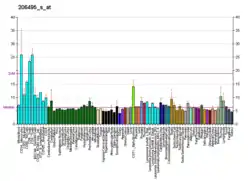MIZF
Histone H4 transcription factor is a protein that in humans is encoded by the HINFP gene.[4][5]
Function
HINFP is a protein that binds to a highly conserved DNA motif found in most histone H4 genes. HINFP activates H4 gene expression through interactions with the CDK2 substrate NPAT which is localized in Histone Locus Bodies. HINFP was independently described as a protein called "MBD2 interacting zinc finger protein" (MIZF). MIZF was reported to interact with methyl-CpG-binding protein-2 (MBD2; MIM 603547), a component of the MeCP1 histone deacetylase (HDAC) complex. MIZF is thought to play a role in DNA methylation and transcription repression.[supplied by OMIM][5]
Interactions
One key partner protein of HINFP is NPAT, a CDK2 substrate that localizes to Histone Locus Bodies. MIZF has been reported to interact with Methyl-CpG-binding domain protein 2[4] and DHX9.[6]
References
- GRCm38: Ensembl release 89: ENSMUSG00000032119 - Ensembl, May 2017
- "Human PubMed Reference:". National Center for Biotechnology Information, U.S. National Library of Medicine.
- "Mouse PubMed Reference:". National Center for Biotechnology Information, U.S. National Library of Medicine.
- Sekimata M, Takahashi A, Murakami-Sekimata A, Homma Y (Nov 2001). "Involvement of a novel zinc finger protein, MIZF, in transcriptional repression by interacting with a methyl-CpG-binding protein, MBD2". J. Biol. Chem. 276 (46): 42632–8. doi:10.1074/jbc.M107048200. PMID 11553631.
- "Entrez Gene: MIZF MBD2-interacting zinc finger".
- Fujita H, Fujii R, Aratani S, Amano T, Fukamizu A, Nakajima T (Apr 2003). "Antithetic effects of MBD2a on gene regulation". Mol. Cell. Biol. 23 (8): 2645–57. doi:10.1128/MCB.23.8.2645-2657.2003. PMC 152551. PMID 12665568.
Further reading
- Medina R, van der Deen M, Miele-Chamberland A, Xie RL, van Wijnen AJ, Stein JL, Stein GS (2007). "The HiNF-P/p220NPAT cell cycle signaling pathway controls nonhistone target genes". Cancer Res. 67 (21): 10334–42. doi:10.1158/0008-5472.CAN-07-1560. PMID 17974976.
- Mitra P, Xie R, Harper JW, Stein JL, Stein GS, van Wijnen AJ (2007). "HiNF-P is a bifunctional regulator of cell cycle controlled histone H4 gene transcription". J. Cell. Biochem. 101 (1): 181–91. doi:10.1002/jcb.21157. PMID 17163457.
- Fukushige S, Kondo E, Gu Z, Suzuki H, Horii A (2006). "RET finger protein enhances MBD2- and MBD4-dependent transcriptional repression". Biochem. Biophys. Res. Commun. 351 (1): 85–92. doi:10.1016/j.bbrc.2006.10.005. PMID 17049487.
- Pulukuri SM, Rao JS (2006). "CpG island promoter methylation and silencing of 14-3-3sigma gene expression in LNCaP and Tramp-C1 prostate cancer cell lines is associated with methyl-CpG-binding protein MBD2". Oncogene. 25 (33): 4559–72. doi:10.1038/sj.onc.1209462. PMC 1526774. PMID 16786000.
- Rual JF, Venkatesan K, Hao T, Hirozane-Kishikawa T, Dricot A, Li N, Berriz GF, Gibbons FD, Dreze M, Ayivi-Guedehoussou N, Klitgord N, Simon C, Boxem M, Milstein S, Rosenberg J, Goldberg DS, Zhang LV, Wong SL, Franklin G, Li S, Albala JS, Lim J, Fraughton C, Llamosas E, Cevik S, Bex C, Lamesch P, Sikorski RS, Vandenhaute J, Zoghbi HY, Smolyar A, Bosak S, Sequerra R, Doucette-Stamm L, Cusick ME, Hill DE, Roth FP, Vidal M (2005). "Towards a proteome-scale map of the human protein-protein interaction network". Nature. 437 (7062): 1173–8. Bibcode:2005Natur.437.1173R. doi:10.1038/nature04209. PMID 16189514. S2CID 4427026.
- Miele A, Braastad CD, Holmes WF, Mitra P, Medina R, Xie R, Zaidi SK, Ye X, Wei Y, Harper JW, van Wijnen AJ, Stein JL, Stein GS (2005). "HiNF-P directly links the cyclin E/CDK2/p220NPAT pathway to histone H4 gene regulation at the G1/S phase cell cycle transition". Mol. Cell. Biol. 25 (14): 6140–53. doi:10.1128/MCB.25.14.6140-6153.2005. PMC 1168814. PMID 15988025.
- Sekimata M, Homma Y (2004). "Regulation of Rb gene expression by an MBD2-interacting zinc finger protein MIZF during myogenic differentiation". Biochem. Biophys. Res. Commun. 325 (3): 653–9. doi:10.1016/j.bbrc.2004.10.090. PMID 15541338.
- Sekimata M, Homma Y (2004). "Sequence-specific transcriptional repression by an MBD2-interacting zinc finger protein MIZF". Nucleic Acids Res. 32 (2): 590–7. doi:10.1093/nar/gkh249. PMC 373363. PMID 14752047.
- Mitra P, Xie RL, Medina R, Hovhannisyan H, Zaidi SK, Wei Y, Harper JW, Stein JL, van Wijnen AJ, Stein GS (2003). "Identification of HiNF-P, a key activator of cell cycle-controlled histone H4 genes at the onset of S phase". Mol. Cell. Biol. 23 (22): 8110–23. doi:10.1128/MCB.23.22.8110-8123.2003. PMC 262391. PMID 14585971.


